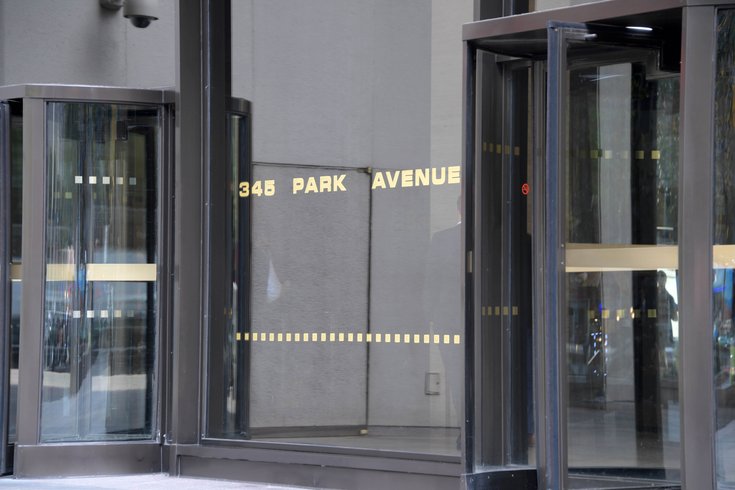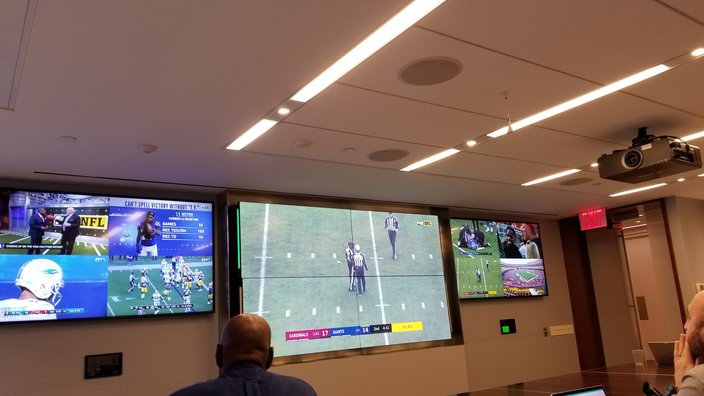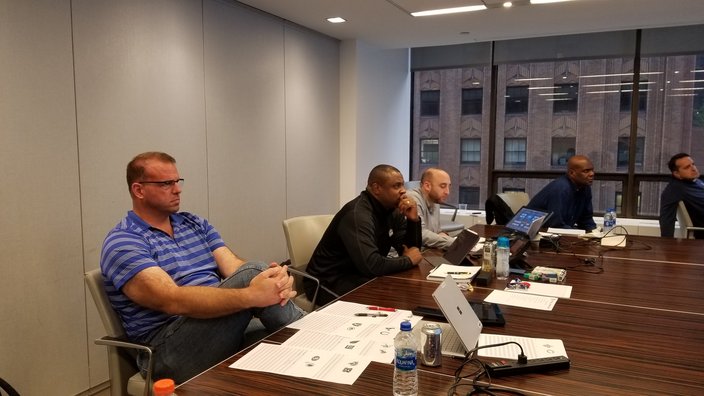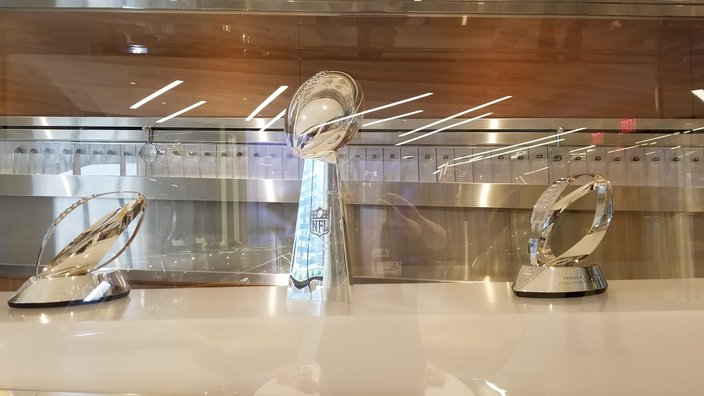
October 31, 2019
 Kirby Lee/USA TODAY Sports
Kirby Lee/USA TODAY Sports
General overall view of the entrance to the NFL Headquarters at 345 Park Avenue in New York City.
NEW YORK — No one would think this is the hub of the football universe. Well-dressed tourists and shaggy stragglers alike sporadically walk by without a hint of what’s about to go inside the building they pass. While National Football League stadiums across the country fill up each Sunday, the league’s main headquarters is quite the opposite. The makeshift overhanging green facade, with the address 345 Park Ave. embossed in gold above a solitary glass door, is as nondescript as it comes.
It’s also wrong.
It’s really Lexington Avenue, but due to the two-year renovation project taking place at 345 Park Avenue, anyone who wants to enter the offices of the NFL needs to go through the back Lexington entrance.
The NFL has been accused of getting a lot of things wrong this season when it comes to officiating.
That’s the assumption from the outside looking in.
The reality, however, is light years different, from how comprehensive each penalty, especially the flagrant ones, are evaluated, then re-evaluated, to the constant contact with network producers, to how far the team benches are from the sidelines, to how accurate the calls are, undergoes relentless internal scrutiny.
Inside, on this particular overcast, raw third Sunday in October — the NFL’s Week 7 — two former Eagles have arrived, Jon Runyan and Troy Vincent. They’re casually dressed, as is everyone on this exhaustive workday. Their day begins around 11 a.m. and won’t end until roughly 11 p.m. or midnight.
Vincent, the NFL’s Executive Vice President of Football Operations answers to only one man, NFL Commissioner Roger Goodell, and Runyan, named NFL’s Vice President of Policy and Rules Administration in 2016, allowed PhillyVoice access to what they do during the 1 p.m. schedule, how they break down games, what they see and what they look for each Sunday.
Inside, what you find takes precedence above everything each Sunday at NFL Operations is player safety. There are literally hundreds of eyes on the game, between NFL headquarters in New York to the venues' game-day staffs, which comb every facet, from hand placement, helmet-to-helmet contact, tackling, and egregious hits — or "kill shots."
There are four nerve centers at the NFL: GameDay Mission Control, where Vincent and Runyan work, which is a conference room of six that stare at a phalanx of TVs that fill an entire wall. In here, they monitor competitive equity, team and player accountability, sideline integrity and log noteworthy plays; the GameDay Operations Center, which contains a host of people in constant contact with the networks and venue operation staff, monitoring commercial breaks, security issues, game day technology and weather; the GameDay Central Compliance Room, which goes over uniform inspection, follows on-site incidents and on-field player and coach accountability; and, finally, the Art McNally GameDay Central, a darkened room that contains the high-tech gadgets that you would see in the control center of a Jason Bourne movie. In here, they do replay review, oversee game management, track challenges and timeouts and log noteworthy plays for the rules committee for educational purposes.
Accompanying Runyan, dressed in blue jeans and a blue striped collared shirt, and Vincent, who’s decked in sheer black sweats at GameDay Mission Control this Sunday are David Gardi, the NFL Senior Vice President of Football Operations, Andrew Dees, a former Temple offensive line coach who has close to 20 years of coaching experience, Jay Reid, the NFL’s senior director of football operations technology strategy and Stephen Bowen, a 10-year NFL veteran who retired in 2015.
Our officials do a great job. They’re there to protect the players and the integrity of the game. We’re here to protect the players and the integrity of the game. But we have a greater job today, trying to change the way the game is played.
It’s not a bunged-up atmosphere of suits. It’s a very relaxed, free-flowing milieu.
What you also notice, on the record and off, is the deep appreciation and respect everyone holds for the game officials. Though highly criticized this season by the media and in the public eye, what you see during the slow-motion breakdowns is how incredibly accurate they are.
“And they’re doing it in live time,” Vincent said. “Our officials do a great job. They’re there to protect the players and the integrity of the game. We’re here to protect the players and the integrity of the game. But we have a greater job today, trying to change the way the game is played. You see the young stars, from where we were just five years ago until now, you’re actually seeing it, week-in and week-out, the player and the coach to what is expected today when playing in the National Football League.
“In the past, there were free runners running down the sideline and a defender would use his helmet as a weapon to knock them out of bounds. Today, we’re still going to see the big hits and the collisions. It’s part of the game. It’s what fans like about the game. But we set this level, where we see free runners, which we saw today, you see the players shoulder in, head out and tackle. In the past, you would see a blindside block, or if you have a kill shot coming, you have to take it. Guys today are turning their back and peeling away, or body blocking.
“Remember, we’re trying to discard a style of play that’s been taught for decades. The coaches, players and officials aren’t getting their just due or the credit for making these phenomenal adjustments on style of play. The game is good when you have that, because everyone wants the same thing: To compete at the highest level and go home. We see it.”
This Sunday, the 1 p.m. games feature Oakland at Green Bay, Minnesota at Detroit, the Los Angeles Rams at Atlanta, Houston at Indianapolis, Jacksonville at Cincinnati, Miami at Buffalo, Los Angeles Chargers at Tennessee, Arizona at the New York Giants, New Orleans at Chicago and the biggest problem the NFL will have in Week 7 is dealing with the torrential downpour during the San Francisco 49ers game at Washington.
Already, there are technical problems in D.C. The rain caused each team to only have one monitor in the coaches’ booth.
Jon Runyan, Troy Vincent and other NFL officials hard at work on gameday.
Runyan sits to Vincent’s right as the former Eagles take their place in the center of the room. Runyan ran off a series of sheets for each individual game that now sit in front of him on the conference table, jotting the time, quarter and infraction if something merits his attention. They’re not exactly wearing the game faces they had during their playing days, though they look intently at the screens before them. Everyone does. There’s little talk, other than Vincent conferring with Reid.
Before them is a bank of TVs, with one large screen in the middle, surrounded by a series of smaller screens that show each game live. Commercials are bypassed here.
“In general, we look for plays that can educate the players and coaches, whether they’re use-of-helmet fouls, a tackle where we see the shoulder and helmet out,” Vincent said during a rare break. “We look for those gray plays we tag to review why certain plays weren’t called and questions I may have for Al (Alberto Riveron, the NFL’s senior vice president of officiating), as to why this was called and why wasn’t this play called. Was this a miss?
“There are a few things here where we listen to audio to make sure the broadcasters are actually communicating what we discussed during the offseason, in particular around injuries and what the process and protocol is around injuries. We don’t want an announcer assuming what an injury is.”
The best teacher in this game is video. It’s why we collect as much video as we can to show what we want. The video doesn’t lie.
Vincent also pointed out good technique and tackling are also heavily noted. For example, Vincent loved the way Rams’ All-Pro defensive tackle Aaron Donald used his hands to shed a block during the Falcons game. Vincent is constantly aware of pad levels and the angles defenders take when tackling.
“The best teacher in this game is video. It’s why we collect as much video as we can to show what we want,” Vincent said. “The video doesn’t lie.”
With 10:02 left in the first half of the Houston-Indy game, Vincent points out that Texans’ stalwart receiver DeAndre Hopkins could have nailed a defender with a blindside block. Instead, Hopkins peeled off.
Vincent stopped the game stream and pointed at the screen that was showing Houston-Indy — “That’s what we want to see,” he said.
In the same game, Houston quarterback Deshaun Watson appeared to throw a touchdown pass with 6:47 left in the first half. But, it was determined he was in the grasp at the time the throw was made and called down by the officials.
“We’re telling our refs if they see it, call it, and they’re doing it in real time and they’re calling what they’re seeing,” Vincent said. “Our refs are 99.9-percent accurate. They’re seeing the plays through, as we’re asking them to do. And, they’re dropping fabric when it’s appropriate. In the Watson play, we’re asking the refs to blow the whistle for the player’s own protection.
“The vast majority of our refs get it right. We all have a chance to see replay, while these guys make the calls when the play is going 110-mph. Their accuracy rate is phenomenal. They have an impossible job and they do it well. They don’t get a fair knock, but it’s part of the game. We get a chance to see everything, from every angle. Our highest priority is preserving the integrity of the game, but also, to protect the players from themselves.
“It’s why we tag good examples and bad examples. We’re primarily here to protect the players from unnecessary risks.”
Runyan said everything on the field that’s called is already tagged (for video replay).
“Sometimes, helmet-to-helmet collisions are hard to see in real time, it’s why I go back on Mondays to look over everything again,” Runyan said. “It’s why I mainly look for big collisions that are real bad. I look over the coaches’ tape, which arrives late Sunday nights. We tag plays for review, for the competition committee and I make sure Al (Riveron) saw what I saw, too, to include it in a coaching tape.
“I’m the one who hits the players with fines, and that comes after a collaboration on Wednesdays. There will be some things where maybe an official may miss a blindside block. You tag those plays, and after all of the supervisor’s grade the officiating crews, we’ll sit down on a big video collaboration and go over everything.
“Is it a foul or not? We’ll go over all of those things. Even if it is a foul, I don’t have to administer discipline on it. It’s very subjective. If there is a fine, everything is slotted, even excessive profanity. That’s rarely called. An official has to hear something for that. I wish all of it was like ‘Your mother wears combat boots.’ It’s just tough to prove. If the officials do hear something, they will throw a flag for unsportsmanlike conduct. Look at what happened to (Cowboys coach) Jason Garrett (in Week vs. the Green Bay Packers on Oct. 6).
“Troy and I look at everything, and Dave (Gardi) and everyone in our room will communicate with officiating when there’s a disqualification. Anything that doesn’t look safe is what I primarily look for. The refs get it right almost all of the time.”
It’s been a relatively clean day when the second half of the 1 p.m. games begin.
But just as Oakland and Green Bay were about to go into halftime, Raiders’ quarterback Derek Carr lunges for a touchdown inside the pylon, when Packers’ linebacker Blake Martinez shoves Carr from behind jarring the ball free near the goal line. The pylon camera reveals the ball was knocked loose before Carr reached the pylon, which resulted in a touchback for the Packers.
About a minute later, a Raider defender was closing in low on Packers’ quarterback Aaron Rodgers, before letting up. A flag was thrown and later picked up.
“The liability is always on the defender — they can’t hit the quarterback low like that, but the referee did the right thing,” Vincent said. “The liability lies with the defender, which is not new. It has always been that way. We’re trying to cut down the amount of penalties in games, but we’re seeing are too many penalties called, but a lot of them are pre-snap calls.
“Going into this offseason, we’re going to try and increase the pace of play. Officials can’t avoid the amount of penalties in a game, because most of them are pre-snap infractions. Increasing the pace of play will probably be our No. 1 priority going into the offseason. We have a pace-of-play project we're going to take a deeper dive into that area.
“If it’s not conclusive, you’ll see a lot of penalties that do stand, because they’re not conclusive. If it’s not conclusive, leave it in the stadium.”
As the day’s 1 p.m. games begin winding down, Atlanta running back Devonta Freeman committed an unwise act — he threw a punch at the Rams’ Donald after an interception by the Rams’ Cory Littleton with 9:43 to play in the third quarter in what eventually was a 37-10 Rams’ victory on Oct. 20. Freeman was ejected and later fined $14,037 by the NFL for unsportsmanlike conduct.
“That’s a typical situation where someone would ask why one player was thrown out and not the other,” Vincent said. “A punch was thrown by No. 24, Freeman, and anytime a punch is thrown, a ref will make the decision that enough is enough. We’re always looking at things to improve the game, and we’re seeing it.
“During the offseason, we’ll revisit pace of play — should we allow a little flinching and let a guy reset as we look at penalty enforcement? It’s something we will look at with the coaches and officials as it pertains to pace and flow. Does a little flinch constitute fabric? We need to examine the pre-snap penalties, because one-third of the fouls are pre-snap.
“We’re not looking to disrupt game flow. Above all, our priority is to protect our players. Our officials are doing that.”
Follow Joe on Twitter: @JSantoliquito
Like us on Facebook: PhillyVoice Sports

 Joe Santoliquito/for PhillyVoice
Joe Santoliquito/for PhillyVoice